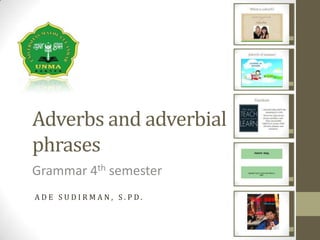Adverbs and adverbial phrases (AdeS)
•Download as PPTX, PDF•
12 likes•10,973 views
Report
Share
Report
Share

Recommended
Recommended
More Related Content
What's hot
What's hot (20)
Adverbial Clause (4th Group English Education Department Of IAIN Salatiga)

Adverbial Clause (4th Group English Education Department Of IAIN Salatiga)
Viewers also liked (8)
Similar to Adverbs and adverbial phrases (AdeS)
Similar to Adverbs and adverbial phrases (AdeS) (20)
What is an Adverbial Phrase Types & Format with Examples.pdf

What is an Adverbial Phrase Types & Format with Examples.pdf
More from Ade Sudirman SC
More from Ade Sudirman SC (20)
Pronouns, adverbs, and simple past tense (structure 1)

Pronouns, adverbs, and simple past tense (structure 1)
Recently uploaded
Making communications land - Are they received and understood as intended? webinar
Thursday 2 May 2024
A joint webinar created by the APM Enabling Change and APM People Interest Networks, this is the third of our three part series on Making Communications Land.
presented by
Ian Cribbes, Director, IMC&T Ltd
@cribbesheet
The link to the write up page and resources of this webinar:
https://www.apm.org.uk/news/making-communications-land-are-they-received-and-understood-as-intended-webinar/
Content description:
How do we ensure that what we have communicated was received and understood as we intended and how do we course correct if it has not.Making communications land - Are they received and understood as intended? we...

Making communications land - Are they received and understood as intended? we...Association for Project Management
https://app.box.com/s/7hlvjxjalkrik7fb082xx3jk7xd7liz3TỔNG ÔN TẬP THI VÀO LỚP 10 MÔN TIẾNG ANH NĂM HỌC 2023 - 2024 CÓ ĐÁP ÁN (NGỮ Â...

TỔNG ÔN TẬP THI VÀO LỚP 10 MÔN TIẾNG ANH NĂM HỌC 2023 - 2024 CÓ ĐÁP ÁN (NGỮ Â...Nguyen Thanh Tu Collection
Recently uploaded (20)
Russian Escort Service in Delhi 11k Hotel Foreigner Russian Call Girls in Delhi

Russian Escort Service in Delhi 11k Hotel Foreigner Russian Call Girls in Delhi
On National Teacher Day, meet the 2024-25 Kenan Fellows

On National Teacher Day, meet the 2024-25 Kenan Fellows
Asian American Pacific Islander Month DDSD 2024.pptx

Asian American Pacific Islander Month DDSD 2024.pptx
Seal of Good Local Governance (SGLG) 2024Final.pptx

Seal of Good Local Governance (SGLG) 2024Final.pptx
Making communications land - Are they received and understood as intended? we...

Making communications land - Are they received and understood as intended? we...
Kodo Millet PPT made by Ghanshyam bairwa college of Agriculture kumher bhara...

Kodo Millet PPT made by Ghanshyam bairwa college of Agriculture kumher bhara...
TỔNG ÔN TẬP THI VÀO LỚP 10 MÔN TIẾNG ANH NĂM HỌC 2023 - 2024 CÓ ĐÁP ÁN (NGỮ Â...

TỔNG ÔN TẬP THI VÀO LỚP 10 MÔN TIẾNG ANH NĂM HỌC 2023 - 2024 CÓ ĐÁP ÁN (NGỮ Â...
Mixin Classes in Odoo 17 How to Extend Models Using Mixin Classes

Mixin Classes in Odoo 17 How to Extend Models Using Mixin Classes
Adverbs and adverbial phrases (AdeS)
- 1. Adverbs and adverbial phrases Grammar 4th semester A D E S U D I R M A N , S . P D .
- 2. Functions • Adverbs often add to the meaning of a verb. •However, they do not always modify a verb. They can modify adjectives, nouns, other adverbs, phrases, and sentences.
- 3. Types of adverbs and adverbial phrases Adverb of manner; Adverb of place; Adverb of time; Adverb of frequency; Adverb of degree; Sentence adverbs.
- 4. Position of adverbs •Adverbs of manner, place, and time usually go after an intransitive verb or after a transitive verb + object. •Adverbs of manner, place, and time can sometimes be placed at the beginning of a sentence for emphasis.
- 5. Position of adverbs •It is also possible to place adverbs of manner and adverbs of indefinite time between the subject and the verb. •If there is more than one kind of adverb in a sentence, the order is usually: manner, place, time.
- 6. Position of adverbs (cont…) • Adverbs of definite frequency are usually placed at the end of a sentence. • Adverbs of indefinite frequency usually go after an auxiliary or the verb to be and before a full verb.
- 7. Position of adverbs (cont…) •Put adverb in the beginning of an imperative sentence. •Adverbs of degree usually go before the words they modify.
- 8. Position of adverbs (cont…) Sentence adverbs can go at the beginning of a sentence, or after the verb to be or an auxiliary.
- 9. Comparison of adverbs •Only gradable adverbs, that is adverbs that can be modified, can have comparative and superlative forms. •(not) as + adverb + as
- 10. Comparison of adverbs (cont. . .) •The + comparative adv, the + comparative adv or adj •Comparative adv + and + comparative adv •Superlative advs are not used very often.
- 11. Assignment 3 •5a, p.22; •6a, p. 24; •6b, p.26. Source : “Grammar Practice for Upper Intermediate Students” (Grammar Module, UNMA 2013)
